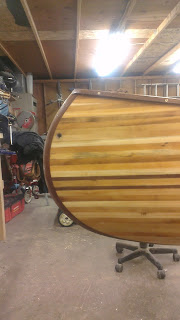So...as the title suggests, I stripped the canoe this weekend. You have no idea how many times I referenced "stripping in the garage" one way or another, without thinking anything of it. Oh well, good times! So, I put the first 2 rows of strips on late Friday night. First, I used a belt sander to shape the plywood inner stems. I had to grind them back to a point, and at the correct angel that the strips will sit on the inner stems at. This wasn't too difficult.
This is how the plywood stems begin. I used the belt sander to round over the top (bottom), and then slowly blend it into a point.
And below, this is what the stems looks like when I was done. They seemed to work perfectly as we stripped the canoe.
After months of planning and preparing, there is a great deal of hesitation when you finally have to pull the trigger and set that first staple. After I had strips on both sides, I used a level to make sure that both sides lined up with each other perfectly...making any minor adjustments as needed. I let these 2 rows set up over night so we would have a nice solid surface to work off of the next morning when my Dad and Brother came over to help strip in the garage :)
With the 2 rows of strips on, we started the morning by adding a row of walnut. I wanted to have 2 rows of walnut, seperated by a row of cedar. This is what my accent strips look like.
Once we got on a roll, the strips went on quickly. The 8 foot boards were rather cumbersome. The sides were built with 3 pieces. For some reason 2 x8 does not equal 17.5 feet! Oh well, I love the way the cedar looks. There are some knots in the wood, and the lighter color looks great with the walnut accent strips. We just keep working out way up the side until we get to the bottom where the curves get too tight to do, then we come from the top down.



The strips came up the sides nice and evenly. We checked it a few times with a level to make sure the rows were even across, but never had to go back and change any spacing. We got up to the football level by lunch time. I then wanted to have a row of walnut accentuate the football design. We had exactly the right amount left over to do this, so we added that row in on both sides. We ran a piece of real dark cedar left over from my brother'c kayak as a centerline, and then work our way back to the sides. These strips are run perfectly straight, and then you have to cut the end at the correct angle to fit in with the sides.


So we keep on with this until we get it all closed in. The last few pieces are a real bugger! Luckily, my Brother and Dad are very good at getting the angles cut perfectly so they seal nicely. I let them work on that as i did most of the glueing and stapling of the pieces that they fit in. This is what it looks like with the top of the canoe all done. We called it a day after this as it was time for supper and we had done enough for one day!


All in all, not a bad days work!
So the next morning, I had to finish filling in the bottowm (which will be the top.) The center line that I started from will be approximately at water level. So i needed to work my way up about 2 rows, and then piece in shorter pieces for the bow and stern. They are all left square and long, and will be cut to the final shape of the canoe later.
We then pulled out all the nails and staples from the top part that we did yesturday and Dad did a quick pass with the belt sander so we could see how it was looking. I will pull rest of the staples later tonight, and either tonight or Monday after work, do more rough sanding with the belt sander.

































































